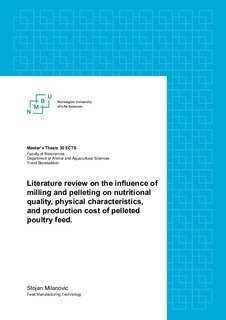| dc.description.abstract | The major objective of poultry feed production is satisfying nutritional requirements, and conversion of macro and microelements into high valuable human food. The economic importance of poultry feed, becomes apparent when it is realized that 60-70% of the total production cost of poultry production is feed. For this reason, the efficient utilization of feed is extremely important in broiler production. The objective of this literature study was to review differences in energy consumption from different studies in the grinding and pelleting process, and to describe how the digestion of nutrients in poultry feeds are influenced by mash or pelleted feed.
Grinding is done due to necessity of mixing several ingredients with satisfying homogeneity. Grinding is done by two highly recognizable systems of production. First and most commonly used is hammer milling. The other type of grinding employed is roller milling. With involvement of 80% of raw materials with necessity for fragmentation, grinding is an important, basic operation in the feed mill. Pelleting is the most prevalent heat treatment in poultry feed production. The main reason why it is so important is that the process leads to agglomeration of smaller particles into bigger particles, the pellets. The grinding process can produce a wide span of particle sizes, depending on the specific needs for pelleted or mash feed. Mash feed provides the opportunity to produce feeds with low investment in feed processing equipment.
The reviewed literature showed that energy consumption is a highly relevant economical factor for the poultry feed industry. In observed studies from 3 different countries, the goal was to compare involvement of energy consumption in the final cost calculation of poultry feed. In experiment from Egypt, grinding process showed that is more suitable for feed production, up to 30% lower usage considering power consumption then pelleting. Study done in Norway documented that, when both grinding and pelleting are observed without any addition of enzymes or water, power consumption in grinding process is 10% less than in pelleting. And in third case from Bangladesh in intensive production, energy cost is the highest in the production of high quality pellets. But differences are small comparing to production of medium and low quality pellets, so it can be neglected because high quality pellets have higher demand %, and it is desirable for serious business giants.
Thus, the main criteria for evaluating optimal particle size in feed were both biotic and economic factors. Briefly, mash diets give greater unification of growth, lower mortality and requires lower use of energy than pelleted feed, making it more economical. Poultry has preferences for bigger particles size, so pelleted feed increases feed intake relative to mash. Pelleted feed also results in lower percentage of waste in feeding, has a better impact on animal respiratory system health, and is also easier to handle, transport and store. On the other side, pelleted feed is about 10% more expensive than the ones not pelleted. This is mostly due to higher energy consumption during production.
A major advantage of pelleted compared to mash feed is increased feed intake. Mash diets give greater unification of growth, lower mortality and requires lower use of energy than pelleted feed, making it more economical. Poultry has preferences for bigger particles size, so pelleted feed increases feed intake relative to mash. Pelleted feed also results in lower percentage of waste in feeding, has a better impact on animal respiratory system health, and is also easier to handle, transport and store. On the other side, pelleted feed is about 10% more expensive than the ones not pelleted. This is mostly due to higher energy consumption during production. Recommendations regarding optimum particle size have, however, been contradictory. The results from feeding trials and different experiments are confounded by a number of factors, including feed physical form, complexity of the diet, grain type, endosperm hardness, grinding method, pellet quality and particle size distribution. Each of these factors consists possibilities to influence on digestibility of poultry feed. From all these factors, grinding method and pellet quality have the highest influence on the poultry production results. The digestibility of poultry feed can be influenced by manipulation of the grinding screen size in the intensive production of high quality pellets.
The main conclusion based on the literature reviewed is that pelleted feeds seem to have more advantages than disadvantages, when compared to mash feed. However, opinions presented in the literature are divided, indicating that both pelleted and mash feeds defend their use in providing optimal nutrition of poultry. | nb_NO |

